The Hybrid Solar Wind Market is estimated to be valued at USD 1.5 billion in 2025 and is projected to reach USD 3.3 billion by 2035, registering a compound annual growth rate (CAGR) of 8.0% over the forecast period.
The pace of growth is front-loaded, with YoY expansion peaking at 8.3 percent in 2028 before easing into the 7.2 to 7.9 percent range toward the end of the horizon. This pattern illustrates a phase of early acceleration fueled by heightened investments in hybridized renewable installations and greater acceptance of decentralized generation models. Incremental gains rise from roughly USD 0.2 billion additions between 2025 and 2028 to USD 0.3 billion annual additions after 2032, highlighting the impact of scale on compounding value. As hybrid configurations demonstrate reliability in grid balancing, their penetration across industrial, commercial, and utility-scale applications is expected to widen. The trajectory confirms that hybrid solar wind systems are emerging as a preferred solution for energy diversification and reliability improvements.
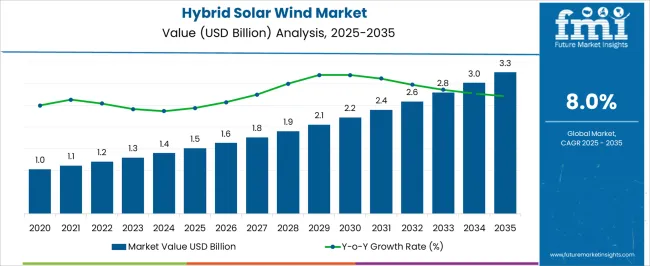
| Metric | Value |
|---|---|
| Hybrid Solar Wind Market Estimated Value in (2025 E) | USD 1.5 billion |
| Hybrid Solar Wind Market Forecast Value in (2035 F) | USD 3.3 billion |
| Forecast CAGR (2025 to 2035) | 8.0% |
The hybrid solar wind market is expanding rapidly due to the increasing demand for reliable and sustainable energy solutions. The combination of solar and wind technologies addresses the intermittency challenges of renewable power generation by leveraging complementary energy sources.
Growing industrial energy consumption and the push toward decarbonization have led many industries to adopt hybrid systems for consistent and clean power supply. Advances in hybrid system design, improved energy storage technologies, and falling costs of solar panels and wind turbines have made these systems more economically viable.
Government policies and incentives promoting renewable energy adoption have also accelerated market growth. Additionally, hybrid systems offer flexibility in installation locations, making them attractive for remote industrial facilities where grid access is limited or unstable. The market outlook remains positive as industries seek to reduce carbon footprints and energy costs. Segmental growth is expected to be led by grid connected hybrid systems due to their integration capabilities and industrial end use driven by high energy demand.
The hybrid solar wind market is segmented by product, end use, and geographic regions. By product, the hybrid solar wind market is divided into grid-connected and standalone. In terms of end use, the hybrid solar wind market is classified into Industrial, Residential, and Commercial. Regionally, the hybrid solar wind industry is classified into North America, Latin America, Western Europe, Eastern Europe, Balkan & Baltic Countries, Russia & Belarus, Central Asia, East Asia, South Asia & Pacific, and the Middle East & Africa.

The grid connected segment is projected to contribute 59.2% of the hybrid solar wind market revenue in 2025, maintaining its dominance among product types. This segment benefits from the ability to feed excess energy back into the grid, improving overall system efficiency and providing financial incentives through net metering.
Grid connected hybrid systems allow industries to supplement grid power with renewable sources, enhancing energy security and reducing dependence on fossil fuels. The growing modernization of power grids and smart grid technologies has facilitated smoother integration of these systems.
Moreover, grid connectivity supports real-time monitoring and management, helping optimize energy use and costs. As utility companies increasingly support renewable integration, grid connected hybrid solar wind systems are expected to remain the preferred choice for large-scale industrial applications.
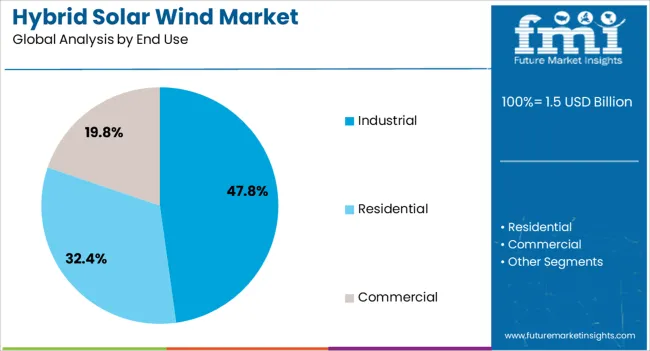
The industrial segment is expected to hold 47.8% of the hybrid solar wind market revenue in 2025, establishing itself as the largest end-use category. Industry sectors with high power consumption have embraced hybrid renewable solutions to achieve sustainability goals and control operational expenses.
The ability of hybrid systems to provide stable and continuous power makes them ideal for manufacturing plants, processing units, and large facilities requiring uninterrupted energy. Many industries face rising electricity costs and regulatory pressure to reduce greenhouse gas emissions, which has accelerated the adoption of renewable energy hybrids.
Additionally, industries located in remote areas or regions with unreliable grid infrastructure benefit from hybrid systems that enhance energy reliability and resilience. The ongoing shift towards greener industrial processes is expected to keep the industrial segment at the forefront of the hybrid solar wind market.
Hybrid solar wind systems are expanding due to rising power reliability concerns, policy incentives, and storage-backed performance. Industrial adoption and rural electrification projects are positioning hybrids as a core component of the renewable transition.
Hybrid solar wind systems are gaining prominence as they provide a balanced energy mix by combining solar and wind generation. Intermittency has been a critical limitation in single-source renewables, and this dual model addresses the challenge effectively. Industrial sites, telecom infrastructure, and remote communities are increasingly adopting hybrid configurations to ensure uninterrupted power supply. The cost reductions in both solar panels and wind turbines are accelerating installations across Asia, Africa, and Latin America. Government-backed electrification projects have integrated hybrid systems into rural development programs. These initiatives, along with commercial investments, are reshaping energy reliability standards. Stronger grid support, coupled with storage integration, enhances operational efficiency and lowers dependency on fossil-based power generation.
Energy storage integration has become a decisive factor in the commercial viability of hybrid solar wind systems. By coupling advanced battery systems, energy stability during low solar radiation or low wind periods is achieved. Lithium-ion and flow battery technologies are commonly used in these projects due to high efficiency and declining costs. In rural microgrids, storage ensures reliable access for healthcare centers, schools, and households. Industrial zones leverage storage-backed systems to prevent downtime in manufacturing operations. The availability of financing models for hybrid plus storage projects is also widening adoption among small businesses. This synergy ensures a steady supply of power, reducing dependence on grid imports while enabling better load management in peak demand hours.
Policy frameworks and supportive regulations are shaping the trajectory of the hybrid solar wind market. Tax incentives, renewable portfolio standards, and concessional loans are encouraging private investment in hybrid projects. Developing nations are receiving global financial support from international agencies to deploy hybrid energy infrastructure in underserved regions. Energy security concerns in developed economies have prompted favorable grid connection policies to promote hybrid adoption. National governments are aligning hybrid energy projects with rural electrification and industrial decarbonization strategies. Competitive tenders and feed-in tariffs are further motivating project developers. The policy push ensures stability in project economics, creating predictable revenue streams that attract both domestic and foreign investors to this evolving sector.
Hybrid solar wind systems are finding greater relevance in commercial and industrial applications where reliable power is non-negotiable. Mining operations in remote regions, telecom tower operators, and manufacturing hubs are among the top adopters. The dual-generation capacity reduces operational risks from outages and high fuel costs associated with diesel generators. Corporations are deploying hybrid solutions to enhance energy self-sufficiency and reduce long-term operating expenses. Hybrid systems also complement energy management systems by reducing fluctuations in supply and ensuring continuous operations. Large enterprises view hybrid adoption as a cost-effective method of energy diversification. This industrial momentum is creating opportunities for technology vendors, engineering firms, and financing institutions supporting hybrid deployment.

The hybrid solar wind market is projected to expand globally at a CAGR of 8.0% from 2025 to 2035, fueled by rural electrification projects, industrial adoption, and enhanced energy storage integration. China leads with a CAGR of 10.8%, supported by large-scale hybrid installations for manufacturing zones, government subsidies for renewable diversification, and remote area electrification programs. India follows at 10.0%, driven by rural microgrids, telecom tower electrification, and private sector partnerships enhancing distributed generation. France records 8.4%, supported by policy-driven hybrid adoption for industrial parks and public infrastructure. The United Kingdom posts 7.6%, with hybrid systems integrated into coastal and island projects for stable power supply. The United States stands at 6.8%, as hybrid installations focus on commercial applications, mining operations, and replacing diesel backup in remote regions. This distribution highlights how supportive policy, industrial power reliability needs, and rural access programs are shaping hybrid solar wind adoption across the world’s leading economies.
China has been positioned to lead global hybrid solar wind deployment as manufacturing zones, industrial parks, and remote provinces are served by paired PV and wind assets backed by storage. A 2025–2035 CAGR of 10.8% is projected, above the global 8.0% path, as large reservoirs, coastal wind belts, and strong utility procurement are leveraged. Earlier growth in 2020–2024 was supported by pilot microgrids for mines and telecom sites, which created bankable references for larger rollouts. Grid code clarity and concessional financing have been reinforced, so hybrid tenders are being sized for multi-MW clusters near demand centers. Seasonal complementarity between monsoon wind and dry-season irradiance has been monetized through availability guarantees. China’s scale advantage and disciplined EPC execution will keep installations elevated across provincial pipelines.
India has been assessed as a high-growth hub where rural microgrids, canal-side solar, and high-wind plateaus allow round-the-clock renewable supply. A 2025–2035 CAGR of 10.0% is anticipated as state utilities procure hybrid power with firm supply windows and penalties tied to availability. The 2020–2024 base was set by telecom tower conversions and industrial captive projects that proved diesel displacement economics. Hybrid parks in Rajasthan, Gujarat, and Karnataka are being configured with storage blocks to smooth monsoon wind variability and evening ramps. Compliance requirements on power quality are improving lender confidence, which supports longer-tenor debt. In my opinion, India’s blend of peak demand growth and resource diversity will keep hybrid awards competitive and scalable.
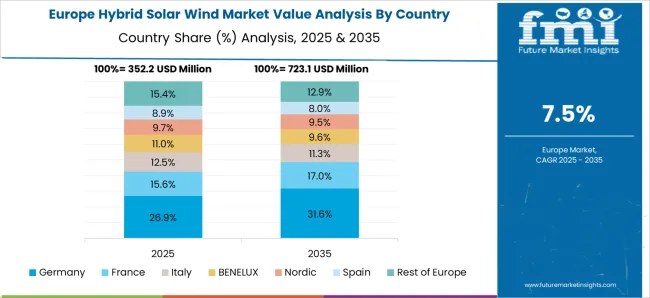
France has been progressing with inland reservoir PV paired to onshore wind corridors to stabilize regional grids. A 2025–2035 CAGR of 8.4% is expected, modestly above the global baseline, as municipal utilities procure hybrids for resilience and cost control. The 2020–2024 period established siting norms on lakes and quarries, which lowered development risk for later projects. Curtailment risk has been reduced through flexible PPAs and smarter dispatch from storage. Industrial estates and water authorities are adopting hybrids to hedge daytime prices while meeting reliability targets. My assessment is that steady permitting discipline, standardized anchoring systems, and stronger EPC capability will keep France’s pipeline consistent and financeable.
The United Kingdom has been shifting from pilot installations to utility-scale hybrids across reservoirs, water treatment sites, and coastal wind nodes. From 2020–2024, CAGR is estimated at 4.8%, shaped by cautious procurement and higher early-stage costs. For 2025–2035, CAGR is projected at 7.6%, approaching the global 8.0% trajectory as tenders specify firm capacity and revenue floors. The rise is attributed to improved float platform durability on inland waters, better wind resource mapping, and falling storage capex that tightens dispatch around evening peaks. Grid services revenues from hybrids are being captured through frequency response and reserve products. Steady policy clarity and maturing EPC supply chains will continue to lift outcomes above the earlier phase.
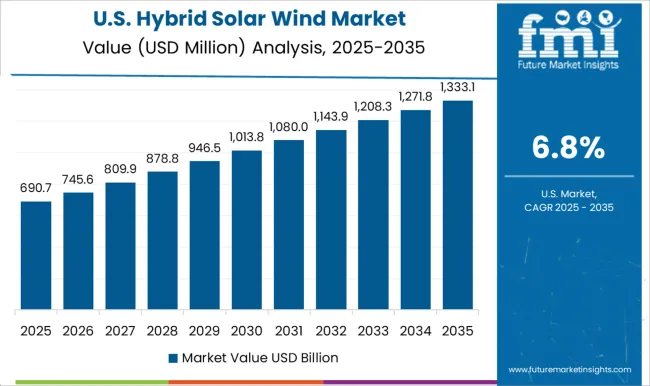
The United States has been deploying hybrids to replace peaker duty and to support remote industry, with growth focused in the Southwest, Plains, and select coastal states. A 2025–2035 CAGR of 6.8% is indicated, reflecting mature market dynamics and interconnection queues that pace delivery. The 2020–2024 period validated hybrid value through mining sites, military bases, and water district projects that sought diesel reduction and resilience. Improved merchant hedges, capacity payments, and storage tax incentives are strengthening bankability. My view is that siting near canals, reservoirs, and brownfields will keep practical pathways open while developers navigate queue reform and equipment lead times.
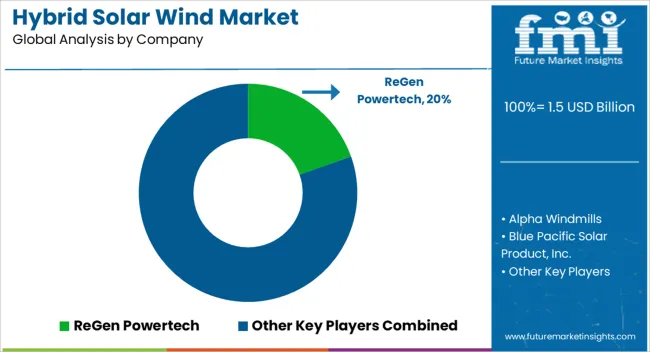
The hybrid solar wind market is represented by a mix of global and regional firms including ReGen Powertech, Alpha Windmills, Blue Pacific Solar Product Inc, Zenith Solar System, UNITRON Energy System Pvt Ltd, Gamesa, Alternate Energy Company, Supernova Technologies Private Limited, Polar Power Inc, and Grupo Dragon.
Competition is defined by system reliability, cost per installed kW, and integration of storage solutions with hybrid arrays. Players are differentiating themselves through project execution capability, localized supply chains, and service contracts that guarantee uptime. Installations are being driven by demand from commercial facilities, rural electrification projects, and government tenders, where hybridization ensures power availability beyond seasonal fluctuations.
ReGen Powertech emphasizes turnkey hybrid wind-solar projects with emphasis on turbine efficiency and grid compliance. Alpha Windmills focuses on compact hybrid solutions targeted at small businesses and off-grid users. Blue Pacific Solar Product Inc highlights its portfolio of modular solar-wind kits aimed at North American consumers and small enterprises. Zenith Solar System integrates hybrid projects into institutional campuses and mid-scale industrial zones.
UNITRON Energy System Pvt Ltd supplies hybrid inverters, controllers, and storage-enabled systems optimized for the Indian subcontinent. Gamesa continues to focus on large utility-scale hybrid parks, supported by its expertise in wind technology and collaborations in solar deployment. Alternate Energy Company directs efforts toward hybrid microgrids for remote communities. Supernova Technologies Private Limited prioritizes hybrid control technologies and predictive maintenance. Polar Power Inc offers hybridized power systems designed for telecom towers and military applications.
Grupo Dragon engages in Latin American hybrid projects with a portfolio spanning solar, wind, and storage installations. Strategic priorities among these firms include optimizing levelized cost of energy (LCOE), improving hybrid controller software for seamless load management, and extending hybrid applications into microgrids, telecom, and industrial estates.
Partnerships with EPC contractors, financing agencies, and storage suppliers are shaping deployment speed. Regional certification, compliance with renewable energy auctions, and alignment with government clean energy targets are being leveraged to scale projects while ensuring local acceptance.
| Item | Value |
|---|---|
| Quantitative Units | USD 1.5 Billion |
| Product | Grid connected and Standalone |
| End Use | Industrial, Residential, and Commercial |
| Regions Covered | North America, Europe, Asia-Pacific, Latin America, Middle East & Africa |
| Country Covered | United States, Canada, Germany, France, United Kingdom, China, Japan, India, Brazil, South Africa |
| Key Companies Profiled | ReGen Powertech, Alpha Windmills, Blue Pacific Solar Product, Inc., Zenith Solar System, UNITRON Energy System Pvt. Ltd., Gamesa, Alternate Energy Company, Supernova Technologies Private Limited, Polar Power, Inc, and Grupo Dragon |
| Additional Attributes | Dollar sales, share, technology adoption trends, policy incentives, pricing benchmarks, grid integration barriers, regional demand hotspots, competitor strategies, project pipeline analysis, and investment opportunities to guide capacity planning and partnerships. |
The global hybrid solar wind market is estimated to be valued at USD 1.5 billion in 2025.
The market size for the hybrid solar wind market is projected to reach USD 3.3 billion by 2035.
The hybrid solar wind market is expected to grow at a 8.0% CAGR between 2025 and 2035.
The key product types in hybrid solar wind market are grid connected and standalone.
In terms of end use, industrial segment to command 47.8% share in the hybrid solar wind market in 2025.






Our Research Products

The "Full Research Suite" delivers actionable market intel, deep dives on markets or technologies, so clients act faster, cut risk, and unlock growth.

The Leaderboard benchmarks and ranks top vendors, classifying them as Established Leaders, Leading Challengers, or Disruptors & Challengers.

Locates where complements amplify value and substitutes erode it, forecasting net impact by horizon

We deliver granular, decision-grade intel: market sizing, 5-year forecasts, pricing, adoption, usage, revenue, and operational KPIs—plus competitor tracking, regulation, and value chains—across 60 countries broadly.

Spot the shifts before they hit your P&L. We track inflection points, adoption curves, pricing moves, and ecosystem plays to show where demand is heading, why it is changing, and what to do next across high-growth markets and disruptive tech

Real-time reads of user behavior. We track shifting priorities, perceptions of today’s and next-gen services, and provider experience, then pace how fast tech moves from trial to adoption, blending buyer, consumer, and channel inputs with social signals (#WhySwitch, #UX).

Partner with our analyst team to build a custom report designed around your business priorities. From analysing market trends to assessing competitors or crafting bespoke datasets, we tailor insights to your needs.
Supplier Intelligence
Discovery & Profiling
Capacity & Footprint
Performance & Risk
Compliance & Governance
Commercial Readiness
Who Supplies Whom
Scorecards & Shortlists
Playbooks & Docs
Category Intelligence
Definition & Scope
Demand & Use Cases
Cost Drivers
Market Structure
Supply Chain Map
Trade & Policy
Operating Norms
Deliverables
Buyer Intelligence
Account Basics
Spend & Scope
Procurement Model
Vendor Requirements
Terms & Policies
Entry Strategy
Pain Points & Triggers
Outputs
Pricing Analysis
Benchmarks
Trends
Should-Cost
Indexation
Landed Cost
Commercial Terms
Deliverables
Brand Analysis
Positioning & Value Prop
Share & Presence
Customer Evidence
Go-to-Market
Digital & Reputation
Compliance & Trust
KPIs & Gaps
Outputs
Full Research Suite comprises of:
Market outlook & trends analysis
Interviews & case studies
Strategic recommendations
Vendor profiles & capabilities analysis
5-year forecasts
8 regions and 60+ country-level data splits
Market segment data splits
12 months of continuous data updates
DELIVERED AS:
PDF EXCEL ONLINE
Hybrid Solar Wind Energy Storage Market Size and Share Forecast Outlook 2025 to 2035
Hybrid Solar Wind Diesel Market Size and Share Forecast Outlook 2025 to 2035
Solar Control Window Films Market Size and Share Forecast Outlook 2025 to 2035
Hybrid Sleeve Cartridges Market Analysis - Size and Share Forecast Outlook 2025 to 2035
Wind Power Forecasting System Market Size and Share Forecast Outlook 2025 to 2035
Solar Module Recycling Service Market Size and Share Forecast Outlook 2025 to 2035
Hybrid Reactive Power and Harmonic Compensation Device Market Size and Share Forecast Outlook 2025 to 2035
Solar Tracking Module Market Size and Share Forecast Outlook 2025 to 2035
Hybrid Vision Sensor Chips Market Size and Share Forecast Outlook 2025 to 2035
Hybrid Printing Market Forecast Outlook 2025 to 2035
Wind Energy Consulting Service Market Size and Share Forecast Outlook 2025 to 2035
Hybrid Boat Market Size and Share Forecast Outlook 2025 to 2035
Hybrid Metal-Paper Seamers Market Size and Share Forecast Outlook 2025 to 2035
Window Air Conditioner Market Size and Share Forecast Outlook 2025 to 2035
Wind Power Coatings Market Size and Share Forecast Outlook 2025 to 2035
Solar Analyzer Market Size and Share Forecast Outlook 2025 to 2035
Hybrid Sealing-Cut Machines Market Analysis - Size and Share Forecast Outlook 2025 to 2035
Hybrid Powertrain Market Size and Share Forecast Outlook 2025 to 2035
Solar Aluminum Alloy Frame Market Size and Share Forecast Outlook 2025 to 2035
Solar Grade Monocrystalline Silicon Rods Market Analysis - Size, Share, and Forecast Outlook 2025 to 2035

Thank you!
You will receive an email from our Business Development Manager. Please be sure to check your SPAM/JUNK folder too.
Chat With
MaRIA